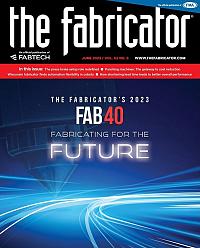Editor
- FMA
- The Fabricator
- FABTECH
- Canadian Metalworking
Categories
- Additive Manufacturing
- Aluminum Welding
- Arc Welding
- Assembly and Joining
- Automation and Robotics
- Bending and Forming
- Consumables
- Cutting and Weld Prep
- Electric Vehicles
- En Español
- Finishing
- Hydroforming
- Laser Cutting
- Laser Welding
- Machining
- Manufacturing Software
- Materials Handling
- Metals/Materials
- Oxyfuel Cutting
- Plasma Cutting
- Power Tools
- Punching and Other Holemaking
- Roll Forming
- Safety
- Sawing
- Shearing
- Shop Management
- Testing and Measuring
- Tube and Pipe Fabrication
- Tube and Pipe Production
- Waterjet Cutting
Industry Directory
Webcasts
Podcasts
FAB 40
Advertise
Subscribe
Account Login
Search
Take the slower, more flexible path to success in metal manufacturing
Move from cost-based to time-based thinking with quick response manufacturing (QRM)
- By Lincoln Brunner
- June 27, 2023
- Article
- Automation and Robotics
When Apple’s “Think Different” campaign debuted in 1997, it featured a who’s-who of famous innovators—among them Amelia Earhart, Miles Davis, and Mahatma Gandhi—who took decidedly idiosyncratic approaches to their pursuits. In doing so, the iconoclasts featured in the campaign redefined their fields.
Rajan Suri thinks fabricators and manufacturers should dare to do the same—both in how they run their shops and how they approach the very concept of productivity.
Suri, author of “It’s About Time” and founder of the Center for Quick Response Manufacturing at the University of Wisconsin-Madison, believes that most manufacturers think wrongly about productivity and profitability, not because they’re unintelligent or bad at what they do, but because they measure money rather than time. Specifically, as he points out in numerous publications, they focus on how quickly their machines can create parts rather than the time it takes for those parts to move from order sheet to machines to a customer’s delivery bay.
“The big picture is that long lead times add a lot of inefficiencies to the whole process,” Suri said. “Long lead times create a lot of other overhead costs. And if you focus on shortening lead time, not only do you take a lot of costs out of your process, [but you also] get better quality, better on-time delivery, and so on. That’s what QRM is essentially saying—focus on reducing lead time as a driver and you’ll get the benefits.”
Of Spaghetti and Cells
Accommodating those new priorities requires a business to rethink many aspects of its operation, beginning with the machines it buys and how it positions them in the shop to optimize the time parts spend in production.
To Suri, it’s all about minimizing what he calls “white space” on the proverbial map of a part’s journey through the shop.
Often, parts follow a “spaghetti flow” through a shop: A part gets laser-cut from a sheet, for instance, then moves to a press brake across the floor, and from there gets tacked to an assembly at a third station before getting welded at a fourth and then stacked on a pallet where it awaits shipment. At all those stations and in between, white space in the production flow kills whatever efficiencies the company might gain during each fabrication process because the machines have not been physically positioned to complement each other in a way that shrinks the white space.
“Think in terms of, ‘How can I find commonalities between parts in order to create a cellular layout?’ because without the part families or the commonality of the cell layout, parts typically go to different departments that have the machines that they need,” Suri said. “Purely automating one operation only means that when you get to that department, you get that operation done faster—but you’ve still got to jog around your spaghetti flow … and you just did a hurry-up-and-wait.
“Putting the parts together based on similar characteristics so that they can all use a group of machines that are in one area and creating the cell essentially takes weeks and weeks out of lead time in many factories,” he noted. “You can have more automated work cells where you hook together two or three or four machines in a sequence. That’s effective if you’re making very much the same product again and again in high volume. For most of the shops that I’m working with, which are high-mix, low-volume or custom production, that is just not a feasible alternative.”Suri noted that multifunctional machines that can punch, cut, and bend (for example) are probably better suited to long production runs of similar parts. Shops living on a consistent diet of small volumes might do well to implement what Suri calls a QRM cell: A combination of machines that can easily and nimbly adjust to highly variable customer demand, in the long run, will likely prove much more profitable.
The idea is to co-locate an array of machines that are more specialized themselves, but when grouped together offer a fabricator a wide array of options so they can respond to a wider array of demands.
“Having a slightly lower level of automation but putting machines together in one place and having the flexibility to take notice of exactly what the customer needs—that's more what I think a lot of shops need in many cases,” Suri said. “It depends obviously on their customers and the market, but for the smaller job shops with really high mix/low volume, then the cells with less automation seem to take less investment and are more flexible.
“As long as those machines are all in the same cell, people can move the parts back and forth in any sequence.”
Adjusting to a Time-Based Mindset
Of course, rearranging a shop like that normally means rearranging the way a shop approaches its entire business, from part flow all the way back to order-taking. The main idea is to squeeze time, rather than costs, out of the process.
Trim Batch Sizes on Purpose. One of the tenets of traditional shops is securing high-volume business to ensure cost efficiencies. However, doing business that way creates excess white space (lead times) in the production flow: wait time for materials, time needed to move large numbers of parts from station to station, time that parts sit waiting for the next process, and the time parts sit on pallets waiting for shipment.
There’s a better way, if an entire operation is oriented to accommodate it—smaller batch sizes that shrink the white space between processes.
“Switching to smaller batch sizes … appears to be more costly from the traditional point of view,” Suri said. “But in fact, because of the shorter lead times and the fast turnaround, you actually end up making more money, and it costs less.”
Resource Utilization. Suri also preaches the virtue of maintaining spare capacity. This may seem antithetical to eliminating white space, but maintaining flexibility means not doing what so many shops have set as their goal: 100% utilization of their people and machinery.
Why not strive for that? Because running flat-out all the time negates the possibility of responding quickly to unexpected demand from current customers, and more important, to requests from new customers. Their orders might take only a short time to fill, but if you’ve maxed out your capacity, you’ve precluded the chance to make a new customer happy and secure new business down the road. You may have optimized your operation for your current book of business, but what happens if that business dries up? Instead of having new business ready and waiting, you’re searching for new business while your machines and people stand idle.
“The biggest thing is looking for machines that are flexible rather than fast,” Suri said. “A lot of times, people want a machine that can just … turn out 100,000 parts in an hour, but those machines typically have really long setups. So, if you have a machine that’s slower but can be changed over very quickly, the slower speed is compensated by the fact that you have fast changeover and short lead times.”
For shops facing material shortages from supply chain issues, Suri suggests that they could make better use of resources by seeking orders for current stock rather than seeking raw material stock for current orders.
“Look at the stock you have on hand that is already with you that is maybe from other orders that didn’t go out or that you just happen to have and get your salespeople to … go after new markets and new customers,” Suri suggested. “If you have cells that are flexible and with short lead times, you can actually pivot very fast to serving new customers with materials you already have.”
Time-Based Sourcing. One of the recurring refrains across the entire North American manufacturing world after the pandemic is reshoring—or at least sourcing much closer to home to avoid the nightmarish wait times suffered by so many businesses that depended on goods from Chinese vendors that arrived weeks or months late during the worst COVID-related delays.
Vying for cheaper parts might have once paid off nicely, but in a time-based system that relies on and aims for short lead times and smaller part runs, sourcing materials closer to home actually boosts the bottom line, Suri maintains.
“Ideally, I would say get in a time machine, go back 20 years, and decide not to outsource those parts to China—but it’s too late for that,” Suri joked. “Use this opportunity to develop alternative suppliers that are possibly apparently more expensive but are local and have short lead times. You can combine that with the cost savings if you have both [foreign and domestic] suppliers in place, so you can place a bulk of your orders to the distant suppliers that might have longer lead times and have fill-in orders filled in by a local supplier.”
About the Author

Lincoln Brunner
2135 Point Blvd.
Elgin, IL 60123
(815)-227-8243
Lincoln Brunner is editor of The Tube & Pipe Journal. This is his second stint at TPJ, where he served as an editor for two years before helping launch thefabricator.com as FMA's first web content manager. After that very rewarding experience, he worked for 17 years as an international journalist and communications director in the nonprofit sector. He is a published author and has written extensively about all facets of the metal fabrication industry.
subscribe now

The Fabricator is North America's leading magazine for the metal forming and fabricating industry. The magazine delivers the news, technical articles, and case histories that enable fabricators to do their jobs more efficiently. The Fabricator has served the industry since 1970.
start your free subscription- Stay connected from anywhere

Easily access valuable industry resources now with full access to the digital edition of The Fabricator.

Easily access valuable industry resources now with full access to the digital edition of The Welder.

Easily access valuable industry resources now with full access to the digital edition of The Tube and Pipe Journal.
- Podcasting
- Podcast:
- The Fabricator Podcast
- Published:
- 04/16/2024
- Running Time:
- 63:29
In this episode of The Fabricator Podcast, Caleb Chamberlain, co-founder and CEO of OSH Cut, discusses his company’s...
- Trending Articles
Tips for creating sheet metal tubes with perforations

Are two heads better than one in fiber laser cutting?

Supporting the metal fabricating industry through FMA

JM Steel triples capacity for solar energy projects at Pennsylvania facility

Omco Solar opens second Alabama manufacturing facility

- Industry Events
16th Annual Safety Conference
- April 30 - May 1, 2024
- Elgin,
Pipe and Tube Conference
- May 21 - 22, 2024
- Omaha, NE
World-Class Roll Forming Workshop
- June 5 - 6, 2024
- Louisville, KY
Advanced Laser Application Workshop
- June 25 - 27, 2024
- Novi, MI



























